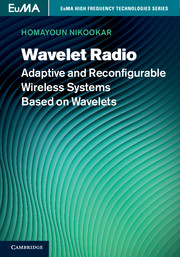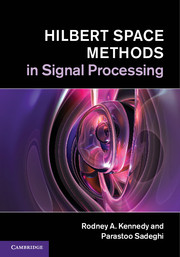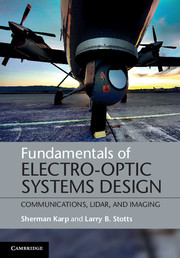Refine search
Actions for selected content:
6791 results in Communications and signal processing
7 - Signals and systems on 2-sphere
- from III - Applications
-
- Book:
- Hilbert Space Methods in Signal Processing
- Published online:
- 05 March 2013
- Print publication:
- 07 March 2013, pp 174-250
-
- Chapter
- Export citation
1 - Introduction
- from I - Hilbert Spaces
-
- Book:
- Hilbert Space Methods in Signal Processing
- Published online:
- 05 March 2013
- Print publication:
- 07 March 2013, pp 2-23
-
- Chapter
- Export citation
Answers to problems in Part II
-
- Book:
- Hilbert Space Methods in Signal Processing
- Published online:
- 05 March 2013
- Print publication:
- 07 March 2013, pp 371-378
-
- Chapter
- Export citation
Index
-
- Book:
- Hilbert Space Methods in Signal Processing
- Published online:
- 05 March 2013
- Print publication:
- 07 March 2013, pp 414-420
-
- Chapter
- Export citation
10 - Reproducing kernel Hilbert spaces
- from III - Applications
-
- Book:
- Hilbert Space Methods in Signal Processing
- Published online:
- 05 March 2013
- Print publication:
- 07 March 2013, pp 321-361
-
- Chapter
- Export citation

Wavelet Radio
- Adaptive and Reconfigurable Wireless Systems Based on Wavelets
-
- Published online:
- 05 March 2013
- Print publication:
- 21 March 2013

Hilbert Space Methods in Signal Processing
-
- Published online:
- 05 March 2013
- Print publication:
- 07 March 2013

Fundamentals of Electro-Optic Systems Design
- Communications, Lidar, and Imaging
-
- Published online:
- 05 February 2013
- Print publication:
- 20 December 2012
List of Abbreviations
-
- Book:
- OFDMA Mobile Broadband Communications
- Published online:
- 05 July 2013
- Print publication:
- 17 January 2013, pp xix-xx
-
- Chapter
- Export citation
1 - Introduction
-
- Book:
- OFDMA Mobile Broadband Communications
- Published online:
- 05 July 2013
- Print publication:
- 17 January 2013, pp 1-8
-
- Chapter
- Export citation
4 - Detection of known binary deterministic signals in Gaussian noises
-
- Book:
- Detection and Estimation for Communication and Radar Systems
- Published online:
- 05 July 2013
- Print publication:
- 17 January 2013, pp 97-148
-
- Chapter
- Export citation
6 - Non-coherent detection in communication and radar systems
-
- Book:
- Detection and Estimation for Communication and Radar Systems
- Published online:
- 05 July 2013
- Print publication:
- 17 January 2013, pp 190-213
-
- Chapter
- Export citation
6 - Inter-cell interference management
-
- Book:
- OFDMA Mobile Broadband Communications
- Published online:
- 05 July 2013
- Print publication:
- 17 January 2013, pp 196-238
-
- Chapter
- Export citation
1 - Introduction and motivation to detection and estimation
-
- Book:
- Detection and Estimation for Communication and Radar Systems
- Published online:
- 05 July 2013
- Print publication:
- 17 January 2013, pp 1-34
-
- Chapter
- Export citation
3 - System design principles
-
- Book:
- OFDMA Mobile Broadband Communications
- Published online:
- 05 July 2013
- Print publication:
- 17 January 2013, pp 70-93
-
- Chapter
- Export citation
4 - Mitigation and exploitation of multipath fading
-
- Book:
- OFDMA Mobile Broadband Communications
- Published online:
- 05 July 2013
- Print publication:
- 17 January 2013, pp 94-149
-
- Chapter
- Export citation
Frontmatter
-
- Book:
- OFDMA Mobile Broadband Communications
- Published online:
- 05 July 2013
- Print publication:
- 17 January 2013, pp i-iv
-
- Chapter
- Export citation
5 - Intra-cell user multiplexing
-
- Book:
- OFDMA Mobile Broadband Communications
- Published online:
- 05 July 2013
- Print publication:
- 17 January 2013, pp 150-195
-
- Chapter
- Export citation
Contents
-
- Book:
- Detection and Estimation for Communication and Radar Systems
- Published online:
- 05 July 2013
- Print publication:
- 17 January 2013, pp vii-x
-
- Chapter
- Export citation
C - Brief review of channel capacity
-
- Book:
- OFDMA Mobile Broadband Communications
- Published online:
- 05 July 2013
- Print publication:
- 17 January 2013, pp 495-502
-
- Chapter
- Export citation
